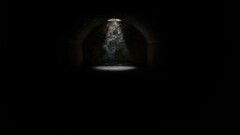Perhaps no area of discernment is more difficult and more controversial than the Christian’s engagement with culture. Are we to be cultural gluttons, immersing ourselves in the culture around us so we can speak to it from the perspective of first-hand experience? Are we to be cultural anorexics, avoiding culture altogether lest it corrupt us? Or are we to take some middle ground where we appreciate aspects of it while rejecting others? In Hollywood Worldviews, filmmaker and screenwriter Brian Godawa (To End All Wars) weighs in on the task of “Watching Films with Wisdom & Discernment.” While looking at movies he seeks to “help the viewer discern those ideas that drive the story to its destination and how they influence us to live our lives—to understand the story behind the story.”
Godawa takes the position that movies both reflect and influence society. Not only do they reflect the worldview and the values of people within society but they also seek to teach others to embrace these values and worldviews. Thus by studying film we can understand cultural trends. We can understand what people believe and what people are going to believe. This arms us as we seek to reach out to this world with the good news of the gospel. “My goal in this book,” he says, “is to increase art appreciation. I want to inform the reader of the nature of storytelling and analyze how worldviews are communicated through most Hollywood movies, in order to aid the viewer’s ability to discern the ideas being communicated.” So his purpose is to reveal to the reader the worldviews underlying film.
After two chapters of introduction to storytelling, Godawa looks to worldviews in the movies, showing through example after example how every movie communicates something of a worldview. The most common worldviews communicated today are existentialism and postmodernism, though others are certainly present to varying degrees. Having discussed worldview, he turns to spirituality and shows how Hollywood has portrayed Christianity, angels and demons, heaven and hell, and faith. A final chapter is titled “Watching Movies with Eyes Wide Open.” Here he warns that “not all movies are worthy of our time or attention, because all stories are not created equal” and he provides several warnings and encouragements for watching movies.
I enjoyed Godawa’s approach to worldview in film and learned a great deal about movies in general and about movies I’ve already seen. I was able to see how I have not been sufficiently discerning in understanding what movies are attempting to communicate. Where I’ve often seen only a nice story, Godawa makes it clear that there is an agenda behind the story—an agenda that I’ve missed completely. I will be watching movies more carefully in the future and will be seeking to discern what lies behind the story. This was a good lesson for me, I’m sure, and one I am glad to learn.
It seemed strange to me, as I read the book, that one of the topics that is likely to be most important to Christians as they consider movies is relegated to an appendix. In the appendix we find “Sex, Violence & Profanity in the Bible.” Here Godawa provides some justification for watching sex and violence in film and for listening to the inevitable profanity. His justification is one I’ve seen countless times—that the Bible contains these themes as well. “The depiction of evil and its destructive ends can be just as true, honorable, right, pure, lovely, excellent, worthy of praise and profitable as can the depiction of righteousness and its glorious ends.” He points to the importance of context as we wrestle with with these issues. In many films these acts happen within an ungodly worldview and in a way that is never redemptive. “Context makes all the difference between moral exhortation and immoral exploitation of sin.”
If the book has a failing, it is right here. Godawa simply does not provide a satisfactory rationale for watching movies in the first place—or at least movies that include sex, violence and profanity. He does warn that “we must be careful to draw personal lines that we will not cross, based upon what particular things affect us negatively when we are exposed to them in movies.” But he gives little by way of universal negatives—things that would (and maybe should!) negatively affect everyone. He seems usually to draw the line not with certain acts or with a certain level of immortality, but rather with good or bad filmmaking and storytelling.
Godawa seems to fall into a trap of equating words and pictures. In so doing he ignores the power of pictures and the fact that pictures and words communicate in different ways. It is for good reason, I am sure, that God chose to communicate through a written rather than a visual Scripture. Equating “he knew her and she conceived and bore a son” with a steamy and passionate scene on the big screen is irrational. Simply because God saw fit to include an element in Scripture does not give us license to portray it visually. It is also important to note that the descriptions of sexuality and violence with the Bible typically arise in historical descriptions. And there is a difference between describing history and fabricating a story. A description of the horrors of the holocaust may be necessary in describing and hence in understanding history. Fabricating a story describing those same stories is not in the same category.
So though I appreciated Godawa’s instruction in discerning the worldviews inherent in film, I was less convinced that this is something we should or need to do. What Godawa set out to do, he did well. He showed that every film communicates a worldview and he gave tools to help discern those worldviews. Perhaps he should have just left the appendix out of the book. Now it would be too simple to say “Godawa is wrong” in teaching that we can watch films laden with negative elements. Rather, he left me unconvinced. I suspect the same will be true of many readers. This oversight aside, I found Hollywood Worldviews, with the exception of that appendix, a good and valuable read.










